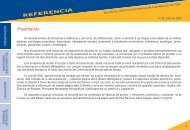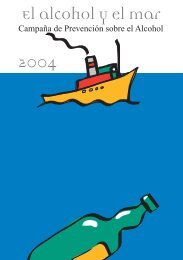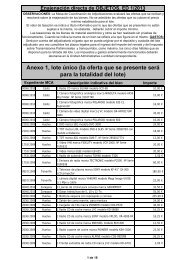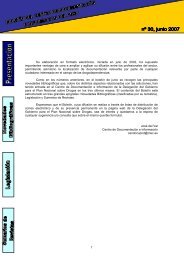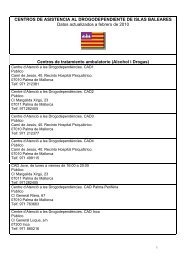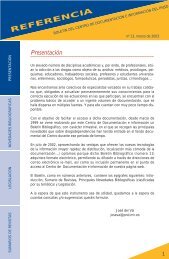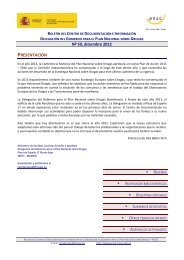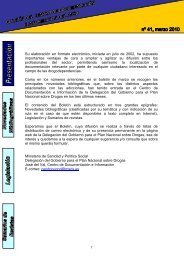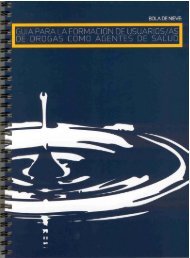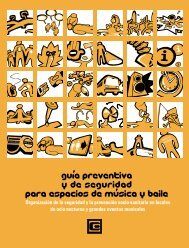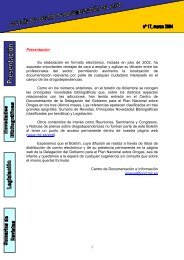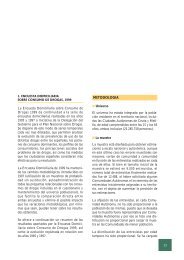MonografÃa Tabaco - Plan Nacional sobre drogas
MonografÃa Tabaco - Plan Nacional sobre drogas
MonografÃa Tabaco - Plan Nacional sobre drogas
Create successful ePaper yourself
Turn your PDF publications into a flip-book with our unique Google optimized e-Paper software.
Tratamiento farmacológico. Terapia sustitutiva<br />
con nicotina<br />
ISABEL NERÍN DE LA PUERTA*, RODRIGO CÓRDOBA GARCÍA**.<br />
* Profesora del Departamento de Medicina y Psiquiatría. Unidad de Tabaquismo FMZ. Facultad de Medicina, Universidad de Zaragoza.<br />
** Profesor del Departamento de Medicina y Piquiatria. Centro de Salud Universitario Delicias Sur.Zaragoza.<br />
Enviar correspondencia a: Isabel Nerín. Unidad de Tabaquismo FMZ. Dpto Medicina y Psiquiatría. Facultad de Medicina, edificio “B”.<br />
C/Domingo Miral s/n, 50009 ZARAGOZA. Rodrigo Córdoba. Centro de Salud Delicias Sur. C/ Manuel Drodna 1. 50009 Zaragoza. E-<br />
mails: isabelne@unizar.es; rcordoba@papps.org.<br />
RESUMEN<br />
La terapia sustitutiva con nicotina (TSN) consiste en la<br />
administración de nicotina por una vía distinta a la del consumo<br />
del cigarrillo en cantidad suficiente para disminuir los síntomas<br />
del síndrome de abstinencia, pero insuficiente para causar<br />
dependencia. Aunque existen pocos análisis comparativos<br />
entre las diferentes presentaciones, los existentes ponen<br />
de manifiesto una eficacia similar para todas ellas.Se ha<br />
demostrado que la TSN reduce los síntomas de abstinencia tras<br />
el abandono total del tabaco, disminuye la ganancia de peso<br />
ponderal y mejora los resultados obtenidos de cualquier otra<br />
forma de tratamiento coadyuvante utilizado si se asocia a ella.<br />
La TSN es eficaz por sí misma, independientemente del nivel<br />
de tratamiento conductual que se aplique al fumador, aunque<br />
cuando se asocia a éste se obtienen mejores resultados y los<br />
programas con mayor intensidad de intervención conductual<br />
más TSN son lo que muestran mayores tasas de abstinencia.<br />
La TSN supone una ayuda para dejar de fumar, lo cual unido a<br />
la escasa entidad de sus efectos secundarios hace que no se<br />
deba escatimar su indicación en ninguna circunstancia. El chicle<br />
requiere cierto adiestramiento para obtener resultados óptimos;<br />
respecto al parche las principales ventajas son la facilidad de uso<br />
y la escasa aparición de efectos secundarios, por lo que resulta<br />
de primera elección para la deshabituación tabáquica en atención<br />
primaria. En cuanto a las tabletas de nicotina, su tolerancia es<br />
muy buena y al igual que las otras formas de TSN ha demostrado<br />
su eficacia y seguridad en el tratamiento de fumadores. El spray<br />
de nicotina alcanza precozmente grandes picos de nicotina en<br />
sangre, por lo que existe la posibilidad de crear adicción. Se ha<br />
valorado la eficacia del tratamiento de fumadores combinando<br />
parches de nicotina y otra forma de TSN de liberación rápida,<br />
concluyendo que esta modalidad terapéutica incrementa la<br />
tasa de éxito. También resulta seguro el manejo de TSN en los<br />
pacientes con enfermedad cardiovascular dado que el riesgo/<br />
beneficio es a favor de TSN. El largo periodo de tiempo durante<br />
el que se ha venido utilizando la TSN permite establecer que el<br />
uso de parche o chicle de nicotina puede considerarse durante el<br />
embarazo cuando el balance riesgo-beneficio sea favorable.<br />
Palabras Clave: Terapia sustitutiva con nicotina. Cesación<br />
tabáquica. Revisión.<br />
ABSTRACT<br />
Nicotine Replacement therapy (NRT) consist on<br />
administration if nicotine by other way different from the<br />
cigarette consumption in quantity enough to reduce symptoms<br />
of abstinence syndrome but not to cause dependence.<br />
Although there are few comparative analysis between different<br />
presentations, those existent show up similar efficacy for all of<br />
them. It has been demonstrated that NRT reduce symptoms of<br />
abstinence after complete smoking cessation, reduces weight<br />
increase and improves results of any other treatment if uses<br />
associate with it. NRT its effective by itself o matter the level of<br />
conductual treatment applied to the smokers, although when<br />
it’s associate to it better results are obtained and programs<br />
with higher intensive conductual interventions plus NRT show<br />
the best abstinence rates. NRT provides help to quit smoking<br />
which added to the limited entity of its side effects makes<br />
important not to lessen its indication in any circumstance. The<br />
chewing gum requires a little training to obtain optimum results.<br />
Concerning the patches main advantage are the ease use and<br />
the limited occurrence of side effects that´s way it becomes<br />
of first election to smoking deshabituation in primary care.<br />
Concerning the nicotine tablets its tolerance is very good and<br />
as well as the other forms of NRT has demonstrated its efficacy<br />
and security on treatment of smokers. The spray of nicotine<br />
reaches promptly high peaks of nicotine in blood therefore it<br />
exists the possibility to create addiction. It has been evaluated<br />
the efficacy of treatment of smokers combining patches and<br />
other forms of NRT of rapid liberation concluding that this<br />
therapeutic modality increases the success, It is also to manage<br />
of NRT in patients with cardiovascular disease, given that the<br />
risk/benefit results in favour to NRT. The long term of time<br />
during which NRT has been used allows to establish that the<br />
use of patches or chewing gum of nicotine can be considered<br />
during pregnancy when the balance risk/benefits is favourable.<br />
Key Words: Nicotine Replacement Therapy. Smoking cessation.<br />
Review.<br />
ADICCIONES (2004), VOL. 16, SUPL. 2<br />
265



